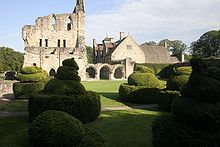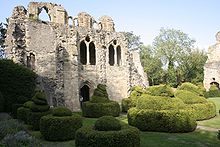- Much Wenlock Priory
-
Much Wenlock Priory is a ruined 12th century monastery, located in Much Wenlock, Shropshire, at grid reference SJ625001. The foundation was a part of the Cluniac order, which was refounded in 1079 and 1082, on the site of an earlier 7th century monastery, by Roger de Montgomery. It is thought to be the final resting place of Saint Milburga, whose bones were reputedly discovered during restoration work in 1101. Today, Wenlock Priory is in the care of English Heritage and is used mostly for recreational purposes. The grounds have a collection of topiary.
Contents
History
Early history
Merewalh, King of the Magonsaete founded the original Anglo-Saxon monastery here circa 680 and Merewalh's daughter quickly became its abbess, and was later canonised. After her death circa 727, however, little is historically known of the monastery until the Norman Conquest. It is known that the priory was inhabited by monks until after the Norman conquest. In the 12th century, the abbey was replaced by a Cluniac priory for men.
Following the reformation of the monastery, in the early fourteenth century, the priory church was lavishly and completely rebuilt, and at today, considerable remains are left of the 350-foot-long church (110 m), including the north and south transept and the nave.
Around the Priory, the town of Much Wenlock was formed. The town is made up of a small network of intricate, narrow streets lined with timber-framed black and white buildings. Within the town is the well of St Milburga of Wenlock which was said to have cured sight impairments and helped Victorian women find a suitor.
Dissolution
Following the dissolution in 1540, several buildings, including the late 15th century Priors House were converted into a private residence. It remains inhabited to this day, and so is not accessible, however the fine architecture can still be seen and incorporates Norman and 15th century work. This gives us a clue of how grand the original priory church would have been.
External links
Categories:- Ruins in Shropshire
- Christian monasteries established in the 7th century
- Monasteries in Shropshire
- English Heritage sites in Shropshire
- Cluniac monasteries in England
Wikimedia Foundation. 2010.



